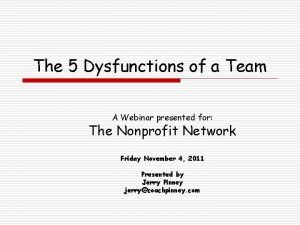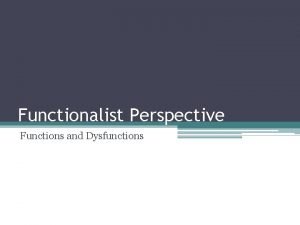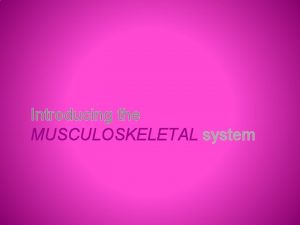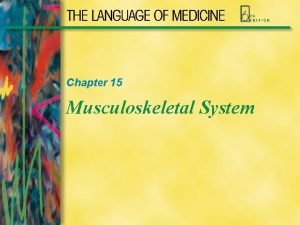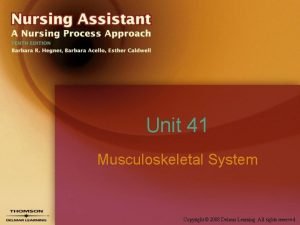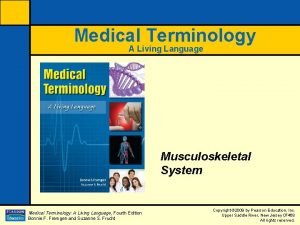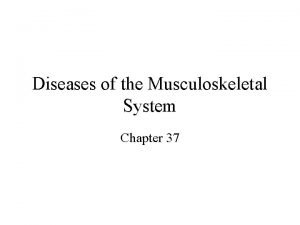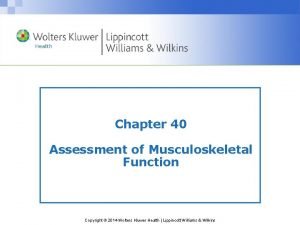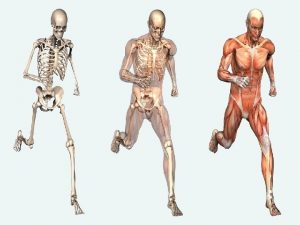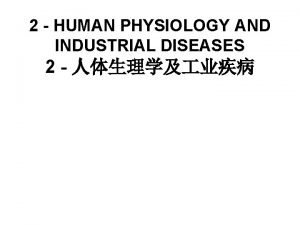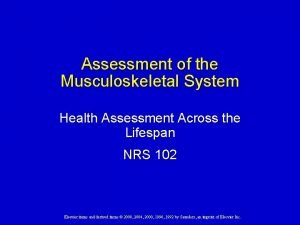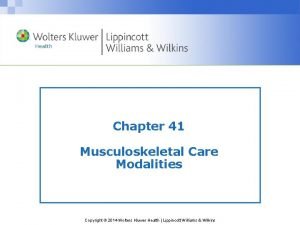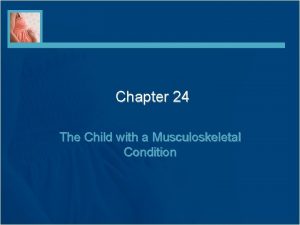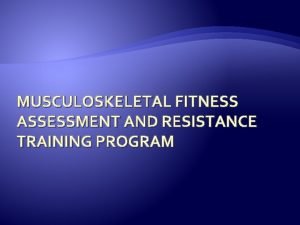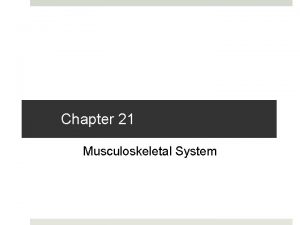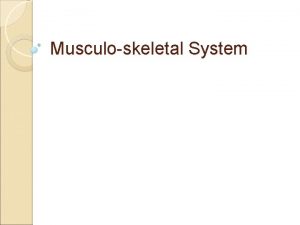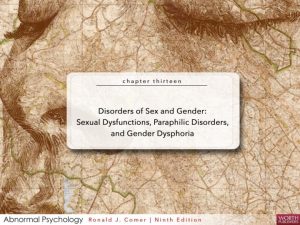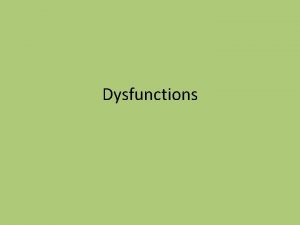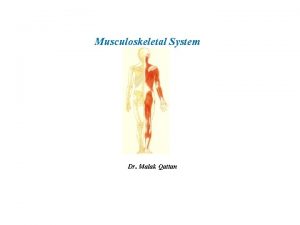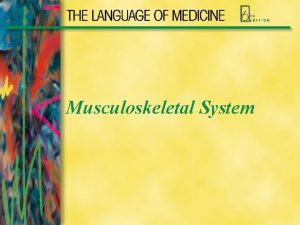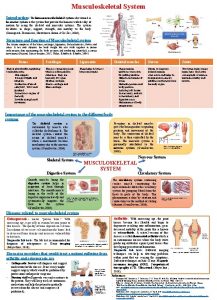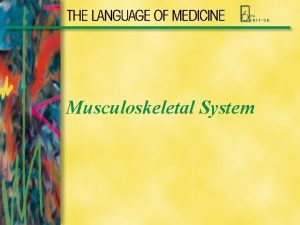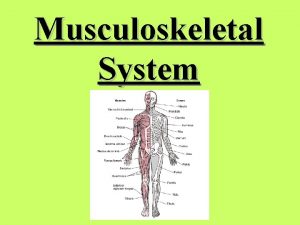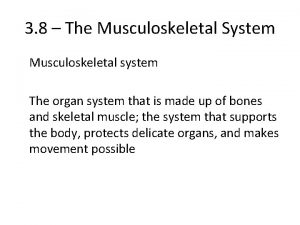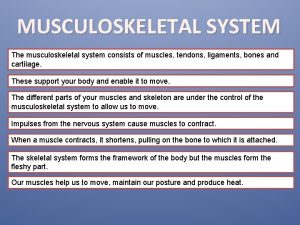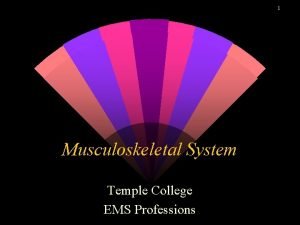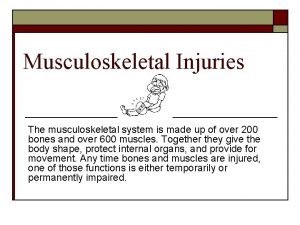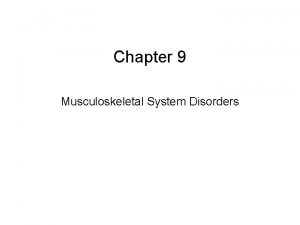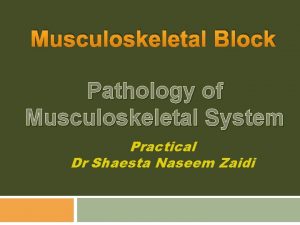DYSFUNCTIONS OF THE MUSCULOSKELETAL SYSTEM Starter What dysfunctions



















- Slides: 19

DYSFUNCTIONS OF THE MUSCULO-SKELETAL SYSTEM

Starter What dysfunctions of the Musculo-Skeletal system are there? Think about what the normal Musculo-Skeletal system does, then think how it can go wrong. You don't have to know the names of the dysfunctions, you can just write down some problems that can occur

Types of dysfunction Arthritis Osteoporosis Multiple Sclerosis Parkinson’s Disease MS and Parkinson’s are not diseases of musculo-skeletal system but their symptoms affect functioning of muscles

Arthritis Condition Inflammation of the joints due to wearing away of cartilage 2 types of arthritis: Osteoarthritis Commonly occurs over age of 55 Leads to permanent damage, stiffness and deformity Rheumatoid – arthritis – Can attack individuals of all ages Leads to misshapen and rigid joints Synovial membrane becomes inflamed and destroy cartilage Scar tissue replaces damaged cartilage which causes the joints to become misshapen More common in females

Arthritis Causes Osteoarthritis Gradual wearing away of cartilage due to age Injury Anything else that causes extra strain on the joints e. g. Overweight/obese Occupational hazard – sports people, dancers etc Skeletal deformities

Arthritis Causes Rheumatoid Precise arthritis cause not known but thought to be due to a virus which causes the body to attack its own tissues by producing antibodies against the synovial membrane (auto immune disease) Synovial membrane becomes inflamed Complications can cause damage to: Heart Lungs Nerves Eyes

Arthritis Symptoms Osteoarthritis: Painful joints making it hard to move Stiff joints Deformed joints Rheumatoid Swollen arthritis joints Raised temperature and other aching joints Misshapen joints

Arthritis Treatment Pain killer drugs (analgesics) Aspirin Ibuprofen - Non-steroidal anti inflammatory drugs (NSAIDS) Corticosteroids injected into joints Joint replacement e. g. Hip replacement Replaced by plastic or metal joints that are cemented in place Other common joints: knees, shoulder, elbow, fingers Physiotherapy: Strengthen particular muscle groups

Osteoporosis Condition Brittle bones – bones become weakened due to loss of protein from the bone More common in females due to drop in oestrogen levels after the menopause

Osteoporosis Causes Decrease in oestrogen (oestrogen promotes bone formation) Removal of ovaries Poor diet Lack of exercise Corticosteroid drugs Heavy smoking Heavy drinking Poor calcium uptake Hormonal disorders Genetic influence – daughters more at risk if mother has

Osteoporosis Symptoms Bones break/fracture easily e. g. coughing or sneezing can cause ribs to fractures causing pain The elderly cannot move about as easily so they quickly become dependent on others to help them Diagnosis X-rays Measurement absorption) Blood tests of bone density (by photon

Osteoporosis Treatment Hormone replacement therapy (HRT) Biphosphonates – to arrest progress of osteoporosis Calcitonin – to reduce effects Calcium tablets – can be taken with HRT Vitamin D Pain killers (analgesics) Exercise recommended for people who are at risk of developing osteoporosis

Multiple Sclerosis Condition Chronic disease of nervous system caused by degeneration of myelin sheath around nerve cells: Myelin sheath covers nerve fibres Myelin insulates the nerve cells allowing impulses (messages) to be carried quickly MS is characterised by periods of remissions and relapses

Multiple Sclerosis Cause Exact cause not known, thought to be due to: a virus that lies dormant until a second exposure or until high stress occurs OR A defective immune system that mistakenly identifies the myelin as ‘foreign’ so attacks it after a viral infection. Genetic influence within a family Symptoms Dragging of one leg affecting walking Double vision

Multiple Sclerosis Diagnosis MRI examinations CT scanning Eye tests – look at speed of responses in the optic nerve Lumbar puncture – fluid is taken from the spinal cord to look for high number of white blood cells

Multiple Sclerosis Treatment No cure, treatment to relieve symptoms Muscle relaxants to ease muscle spasms Corticosteroid drugs to reduce inflammation B-interferon Surgery to halt tremors

Parkinson’s Disease Condition Disease of the nervous system - a neurological degenerative disease characterised by tremors Often occurs after age of 60 Cause Exact cause not known Known that a chemical imbalance occurs: Low levels of Dopamine (a neurotransmitter)

Parkinson’s Disease Symptoms Tremors Slurred speech Small muscle movements difficult so cant eat, write etc Stiff and slow movements (rigidity) Depression common Diagnosis Medical history, physical examination and observation of symptoms

Parkinson’s Disease Treatment Levadopa drug – is converted to dopamine in the brain Anticholinergic drugs to reduce nerve to muscle transmission and so reduce tremors and rigidity. Physiotherapy and hydrotherapy to ease muscles spasms
 5 dysfunctions of a team powerpoint
5 dysfunctions of a team powerpoint 5 dysfunctions of a team questions
5 dysfunctions of a team questions Dysfunctions of deviance
Dysfunctions of deviance Chapter 21 the musculoskeletal system
Chapter 21 the musculoskeletal system Types of joint movement
Types of joint movement Chapter 6 musculoskeletal system diseases and disorders
Chapter 6 musculoskeletal system diseases and disorders Chapter 15 musculoskeletal system step by step
Chapter 15 musculoskeletal system step by step Unit 41 musculoskeletal system
Unit 41 musculoskeletal system Musculoskeletal system
Musculoskeletal system Medical terminology
Medical terminology Diseases of the musculoskeletal system
Diseases of the musculoskeletal system Assessment of the musculoskeletal system
Assessment of the musculoskeletal system Muscle strength scale
Muscle strength scale Musculoskeletal system
Musculoskeletal system Objective data for musculoskeletal system
Objective data for musculoskeletal system Musculoskeletal icd 10 codes
Musculoskeletal icd 10 codes Muscle loss icd 10
Muscle loss icd 10 Chapter 40 musculoskeletal care modalities
Chapter 40 musculoskeletal care modalities Chapter 24 the child with a musculoskeletal condition
Chapter 24 the child with a musculoskeletal condition Musculoskeletal fitness
Musculoskeletal fitness

